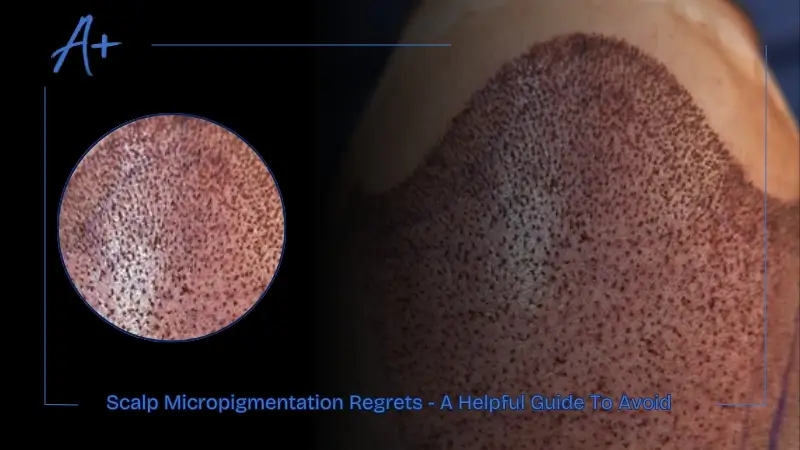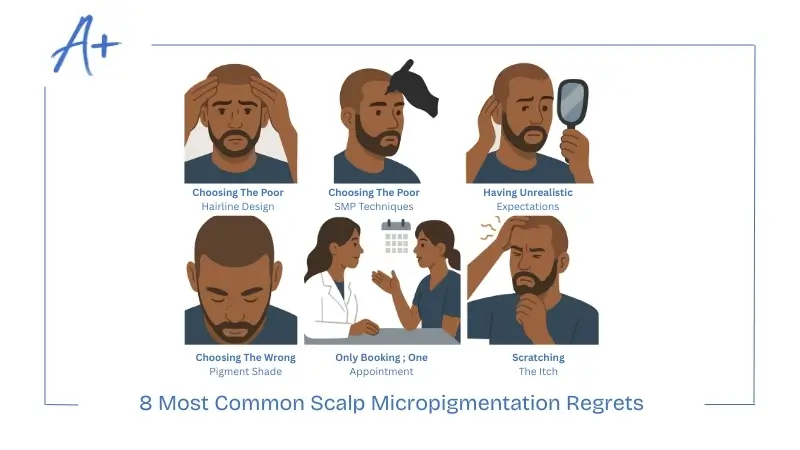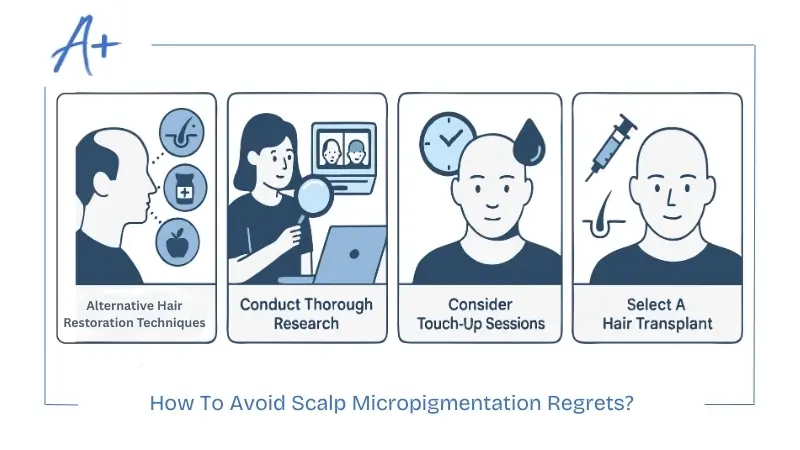
Scalp micropigmentation (SMP) stands as a favored choice over traditional hair transplant because it offers a successful solution for those dealing with hair loss or thinning . This innovative hair restoration approach improves hair appearance by adding density to scalp areas through the strategic placement of pigment dots.
While SMP presents valuable opportunities, individuals must be aware of its limitations. Some people experience regret after getting scalp micropigmentation because they did not conduct sufficient research or relied on incorrect information.
This article outlines the regrets people face from scalp micropigmentation treatments and provides valuable tips to prevent those issues.
What Is Scalp Micropigmentation?
Scalp micropigmentation is a non-surgical procedure that serves as an effective hair restoration method, using small needles to apply pigment for scalp coloring.
It requires multiple sessions and produces results with no recovery time needed. The history of scalp micropigmentation dates back to ancient cultures’ that used tattoos for therapeutic purposes.
Artistic specialists replicate hair follicles effectively, which results in a natural-looking outcome. SMP offers more permanent results compared to wigs and transplant procedures because it eliminates concerns about bleeding and dry scalp irritation.
Note:- Before choosing SMP as an option, evaluate all possible alternatives to minimize the risk of future discontent.
8 Most Common Scalp Micropigmentation Regrets
Scalp micropigmentation results can suffer from treatment quality issues that create dissatisfaction among patients. Since SMP is a permanent aesthetic enhancement, don’t compromise on it, as it requires daily commitment.

Choosing The Poor Hairline Design
Scalp micropigmentation offers the main benefit of establishing a hairline that appears completely natural. Many people regret their SMP results when their hairline looks sharp or artificial due to poor selection at the start or a bad experience with a technician.
A natural-looking hairline is essential in SMP, so patients must watch for any problems in the hairline’s outline.
Evaluate your SMP specialist’s experience by reviewing their past clients photos to see if they create natural-looking hairlines. It is advisable to search for photographs of hairline outlines created through SMP and present these images to your technician for inspiration.
Failing to do so may lead to regret if the final results do not match your expectations.
Choosing The Poor SMP Techniques
Many clients regret their SMP results when they choose inexperienced technicians. Ensure your SMP specialist is qualified and experienced, and that they employ the right procedures to create natural looking hair.
Depending on their desired style, individuals will need different methods. Techniques that yield optimal results include:
-
-
- Ensuring accurate pigment deposition at the appropriate depth.
- Randomly changing the pigmented dot pattern.
- Checking for skin responses by doing a patch test.
- Positioning the needle at the correct angle relative to the scalp surface.
-
Select a trustworthy facility and an experienced SMP technician to avoid future regret, as scalp structures can be more complex than anticipated.
Having Unrealistic Expectations
One major cause of regret is having unrealistic expectations. Micropigmentation for hair loss can provide effective results, but your scalp appearance will not necessarily look fuller if you lack hair.
The application of tattoo pigment to the scalp does not create the illusion of thick or dense hair volume. Unreasonable beliefs about quick procedure progress and time-enhanced outcomes will lead to disappointment and regret regarding scalp tattoos.
Scalp tattoos produce temporary improvements in appearance but generate inferior results compared to hair transplant surgeries. The growth of new healthy follicles results in successful transplantation, while the permanent nature of tattoo ink causes it to fade gradually over time.
Inappropriate Aftercare
Although the process is less intrusive and heals faster than other procedures, it still requires careful attention. Poor aftercare can compromise outcomes and lead to dissatisfaction.
Always follow the helpful scalp micropigmentation advice from the expert performing your procedure throughout your recovery.
Don’t scratch the scalp, stop touching your head needlessly, avoid using shaving machines on the scalp and eliminate the use of fitted caps.
Non-compliance with medical guidelines and mistakes made in scalp micropigmentation can lead to unwanted outcomes and post-operative regret.
Choosing The Wrong Pigment Shade
Your choice of pigment shade is important for achieving natural-looking and optimal results. Since skin tones vary significantly, clinicians must match pigments to each individual’s complexion and customize them, rather than applying a one-size-fits-all method.
They should produce a specific hue that closely resembles your skin tone. One excellent method to prevent regret is to discuss pigment selection beforehand and test a swatch against your skin before the procedure.
Only Booking ; One Appointment
Many people believe that scalp micropigmentation can provide flawless results in a single session, but patients sometimes need multiple sessions to achieve the desired outcomes.
It is essential to avoid booking a single session with the expectation of satisfactory results. Additional sessions may be required, leading to increased costs and time spent in the clinic to attain the desired appearance.
Scratching The Itch
Patients who undergo SMP alongside hair transplant techniques may experience worsening itching and skin redness as a side effect.
Excessive scalp scratching disrupts pigment distribution, even though normal post-treatment itching is expected. However, avoiding this potential scalp micropigmentation regret is simple:
-
-
- Use antihistamines to alleviate itchiness.
- Delay head-shaving until your scalp has fully healed.
- After a hair transplant, proper care of your hair grafts is essential to prevent regrets.
- Wear a loose-fitting hat and gloves to protect your scalp when itchiness occurs.
-
Not getting SMP Sooner
Some individuals regret not having their scalp micropigmentation done sooner because they love the outcomes. It is essential to take your time and do some research when making a decision about SMP.
You must compare different hair loss solutions and follow expert advice to prevent any regrets related to micropigmentation in the future.
Choose only a reputable clinic for your procedure. Consult several providers, evaluate which clinic best suits your needs, and then proceed with your SMP procedure.
How To Avoid Scalp Micropigmentation Regrets?
It is important to prevent scalp micropigmentation regrets. By adhering to these tips, you can avoid ending up with an undesirable outcome.

Alternative Hair Restoration Techniques
Choose scalp micropigmentation only after carefully evaluating other hair restoration methods together with their respective advantages and disadvantages.
The treatment techniques for hair restoration include;
- Hair transplantation methods
- Minoxidil medications
- Finasteride treatments
- Proper nutrient intake
Conduct Thorough Research
Be cautious before selecting the first clinic you come across. Research different clinic facilities to identify the one that will deliver the best treatment results.
Reviewing pictures of completed work gives prospective patients insight into what they can expect from the treatment.
Consider Touch-Up Sessions
Learn about the touch-up policies before starting your treatment, as they affect the results. Regular touch-up sessions maintain pigment saturation while reviving the appearance of scalp micropigmentation.
Maintaining proper hydration for your scalp helps keep pigments vibrant, thus preserving the treatment’s color outcomes.
Plan for yearly touch-up sessions within your maintenance schedule to extend the longevity of your treatment effects. Review all issues or treatment objectives with your physician before starting each session.
Always follow the aftercare instructions provided by your practitioner to maximize the results of each treatment.
Select Advanced Tricopigmentation
A similar procedure to scalp micropigmentation available in the market is advanced tricopigmentation. Many people now prefer this method because it produces finer, more natural-looking strokes that closely resemble real hair follicles.
Although the procedure may take more time, the enduring result justifies the investment.
Consider A Hair Transplant
A hair transplant involves a more complex surgical process compared to scalp micropigmentation. The surgical procedure provides authentic hair that grows naturally.
Hair transplant procedures enable gradual hair growth that produces an extremely natural result over time. It is the most suitable procedure for those who want to avoid future regret from getting a hair tattoo, as it provides superior hair restoration results.
Frequently Asked Questions
Can you tell if someone has scalp micropigmentation?
Properly executed scalp micropigmentation (SMP) creates results that closely replicate natural hair so people cannot detect prior treatment through observation. However, improperly executed SMP may be readily noticeable.
What does SMP look like after 5 years?
Scalp micropigmentation produces a visible but slightly softer appearance that persists over time for up to 5 years. Color fading occurs over time, thus presenting a natural hair appearance compatible with genuine hair strands.
Do any celebrities have scalp micropigmentation?
Yes, it is commonly believed that celebrities Jamie Foxx, Vin Diesel and Alex Beresford have received scalp micropigmentation (SMP).

